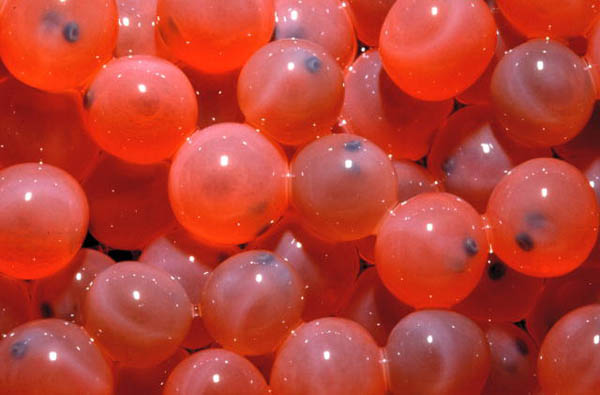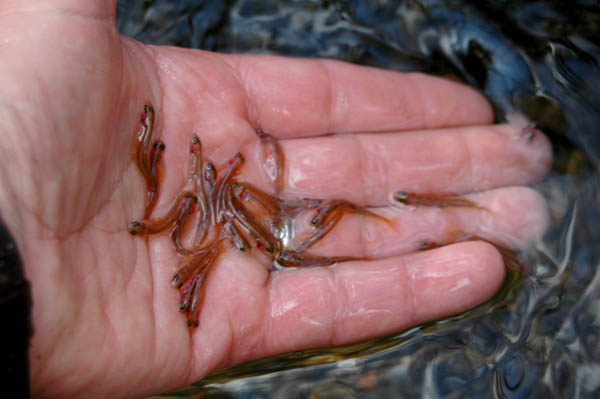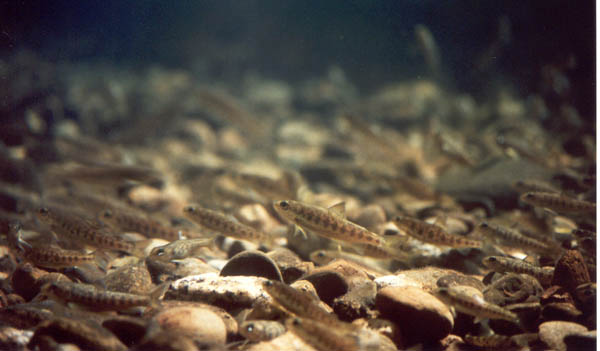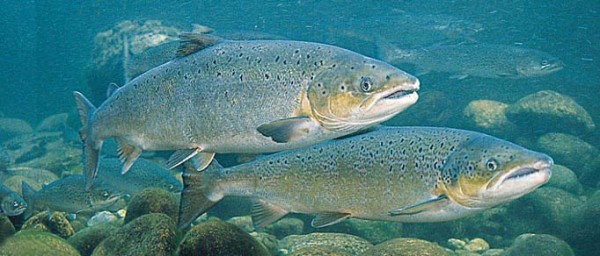Egg by Egg, Department of Marine Resources restoring Atlantic salmon to Maine rivers. Effort to introduce Atlantic salmon roe to Sheepscot River in Palermo uses innovative technique.
By Paul Koenig

Department of Marine Resources biologist Jason Overlock, right, drills a redd for salmon roe Tuesday, as his colleague, Jason Bartlett, center, places a funnel for biologist Paul Christman, left, to insert Atlantic salmon eggs into the bed of the Sheepscot River in Palermo. DMR is using a novel technique, of blasting the bottom of the river with a high-pressure hose, to create the proper environment for inseminated eggs to hatch.
[dropcap]M[/dropcap]aine state biologists working in shallow river tributaries reachable by dirt roads and snowmobile trails are on the front line of the battle against extinction of the Atlantic salmon.
They visit the waterways in January and February, sometimes dragging their equipment on a plastic sled more than a mile to the sites, to mimic wild salmon spawning. They’re planting thousands of eggs in the gravel of riverbeds, an effort mostly funded through a federal grant.
Near a site along the Sheepscot River, Maine Department of Marine Resources biologist Paul Christman prepared the salmon eggs, carefully lifting the tiny, pinkish-orange orbs wrapped in damp cheesecloth and placing them into a wide-mouthed beverage cooler.
The eggs, fertilized last fall at Green Lake National Fish Hatchery in Ellsworth, have developed small black specks for eyes and are no larger than the tip of a child’s pinkie finger. They’re stronger than recently fertilized eggs, Christman said.
While Christman fetched the eggs, Jason Overlock and Jason Bartlett, two other biologists for the department, worked in icy, foot-deep water to prepare the nests.
They pressed a long metal funnel into the ground with a cross-shaped pipe connected to a water pump, mounted on a backpack frame, with plastic tubing.
Overlock swung the standing pipe back and forth, digging the metal funnel into the ground, as the blue tubing behind him followed the movement. The gas-powered pump blasted water into the ground through the pipe, allowing the funnel to be pushed into the riverbed and create a hole for the eggs. After reaching the desired depth in the ground, Overlock lifted the pipe out of the funnel, which was now stuck in the gravel.
Christman scooped a cupful of about 500 eggs and lowered his arm into the cone to release the eggs.
The eggs are negatively buoyant, so they fall gently to the bottom of the hole, Christman said.
After the eggs settled, Christman rotated the cone slightly as he pulled it out of the gravel bottom.
If all goes well, Atlantic salmon will hatch from the man-made nest, also known as a redd, by the end of May. After living in freshwater for two years, they’ll swim downstream to the Atlantic Ocean before returning to the river to spawn in 2017.
Christman and the other biologists at the Marine Resources department first experimented with hydraulic salmon egg planting methods in 2007 after Christman heard about biologists in Alaska doing it.
The original design had eggs being dropped from the top of the pipe, instead of the more gentle funnel method. Christman said they altered the design in 2009 with the separate funnel piece to protect the eggs better.
They first started large-scale planting in 2010 in the Sandy River, a tributary of the Kennebec River. This is the second year they’ve conducted large-scale planting in the Sheepscot River in Palermo.
Salmon from the first large-scale planting would be returning to spawn in 2014.
“The real test will be when, and if, adults show up,” Christman said.
Last year, Christman and his team planted around 1.3 million eggs in Sandy River, the Penobscot River and its Cove Brook tributary, and the Sheepscot River, he said.
Christman said he’s optimistic about the groundbreaking new egg-planting method.
“We’re really hopeful that we’re going to be able to turn the tide and actually increase the number of adults coming back,” he said. “If we can do that, it will, to a certain degree, make some of our other supplementations obsolete.”
Fishing for solutions
Christman said their other methods have never been able to increase the number of wild spawners and fish permanently.
The Marine Resources department, in cooperation with the National Oceanic and Atmospheric Administration Fisheries Service, supplements the wild Atlantic salmon population with different stages of the fish in order to maintain genetic diversity.
The department is in its second year of a five-year NOAA grant, which funds the Atlantic salmon restoration efforts, said Oliver Cox, director of the Sea-Run Fisheries and Habitat Division at the marine resources department.
It received $700,000 this year, a 40 percent reduction from the first year; and the department anticipates similar funding next year, Cox said.
Besides the egg planting, the state biologists release salmon as fry, its first stage after emerging from the egg sac and gravel; parr, the stage living in the river for around two years; and smolt, which are ready to leave for the ocean.
Each year, they stock around 3.5 million fry, 250,000 parr and 650,000 smolt, according to Cox
The advantage of eggs, Christman said, is that the salmon will learn more essential traits — such as avoiding predators — that they don’t acquire when growing up in the hatchery.
“We put them in as eggs; they’re on their own. They’ve got to emerge,” he said. “They’ve got to fend for themselves, and what we’re finding is they’re much stronger.”
Cox said the trade-off with planting eggs instead of releasing grown fish is that fewer fry will emerge from eggs in the wild compared to in the hatchery.
He said that if they planted 700,000 eggs, around 200,000 fry might emerge. But closer to 90 percent of eggs in a hatchery will yield surviving fry.
Christman said there’s very little data on wild spawning and production. But preliminary results of hydraulic planting show that it produces a similar population to what would have survived from eggs brought in by female salmon.
“Once they begin stream life, their survival is much better than stream stocking,” he said. “That’s what’s encouraging, even though we lose some right off.”
Uncertain future
The Atlantic salmon program’s main focus is protecting the genetic diversity of the species to counteract the environment’s selective pressure, said Christman.
Without the diversity, a drastic change in the environment could be “catastrophic” to the Atlantic salmon population, he said.
“We’re in the phase of trying to prevent extinction, if you will,” Cox said.
A much larger restoration effort would be needed to begin growing the population to larger than just what is needed for the hatcheries, Cox said.
Maine had a banner year in 2011 for the number of adult Atlantic salmon returning to the rivers to spawn: more than 3,000 fish.
But last year only around 700 salmon — 624 in the Penobscot River — returned from sea.
The Penobscot River makes up nearly the entire population of returning salmon because it is one of the only waterways stocked with smolt — those about to leave for the ocean.
Cox said there was no change in supplementation numbers in the previous years, so the difference was in the salmon surviving while at sea.
The cause isn’t clear, but he said theories of why the survival rate dropped so significantly range from changes in currents or ocean temperature to prey availability or changes in predator fields.
There isn’t much the state can do to fix the low marine survival rate besides trying to grow the river herring numbers to provide alternatives for predators, Cox said.
“We can put a lot of fish in the river, but we can’t stock enough to overcome the poor marine survival,” he said.
Christman is optimistic that hydraulic planting could replace fry stocking by generating fish more prepared to face the dangers of migrating to the ocean and back.
They won’t know until 2017 whether the salmon produced by the eggs planted this year will create the stronger fish Christman is hoping for. Even then, it may be difficult to know whether other variables affected the number of spawners.
During the Palermo outing Tuesday, the biologists planted about 35,000 salmon eggs in their man-made redds in the Sheepscot River.
Christman expects to plant about 1 million eggs by the end of the season.
“This a drop in the bucket,” Christman said, as he sorted thousands of salmon eggs into different beverage coolers from white plastic foam trays stationed in the bed of the department’s pickup truck. “This is really, really small-time.”






